Singapore March 10 & 11
Singapore, the city we have all heard so much about and their strictness. It sits at the tip of the Malay peninsula. We were informed on the ship not to bring gum ashore, although the only thing illegal is to sell it. We were told by a guide (??) that the reason it was outlawed was that people were sticking it on the doors of the elevators in high-rises, disabling the elevator because the doors would not close and doing the same to the subways… You judge the veracity of this story.
I can say with certainty that one of our ship lecturers tells of a visit to Singapore several years ago when the man in front of him had long, hippy hair. As soon as this man set foot on Singapore, two men took hold of each of his arms, sat him in a chair and cut his hair on the spot.
Singapore consists of 64 islands, much of which is reclaimed land. North South it is 24 kilometers, and East-West 49. There are 33 rivers on these island, ranging in length from 3 to 10 kilometers. Besides being very small it is very wealthy.
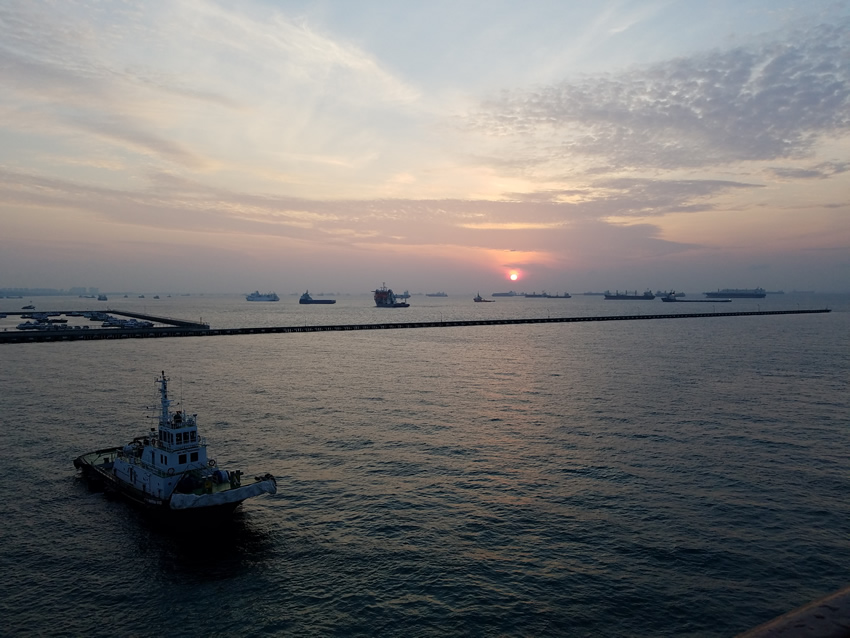
The above picture was taken shortly after sunrise from my stateroom. Just a few of the many ships there.
In 224 sq. miles they have a population of 5,839,410. There are no homeless in Singapore. The government builds houses for all, and finds them work. Everyone works. Their work hours are like ours, except 6 days a week instead of 5. There is no jury trial here, it is all by a judge. Although no one officially said so, there is sort of a one party rule here, a benevolent dictatorship with, I think, a plan for passing on the mantle of power.
The harbor where we were moored has about 1000 boats of all sizes. Many are freighters anchored waiting for a dock. Every 3 minutes a ship either leaves or enters this deep-water harbor. Singapore is building a new harbor on the west side of this island which should be open by 2020.
The occupation by the Japanese during WW II was a difficult time. The Chinese, as in other places in SE Asia, were treated horribly. In 1959, Singapore broke with Great Britain. In 1963 they became part of Malaysia and in 1965 left that union. 25% of their land is reclaimed, a not inexpensive proposition. They are very technologically advanced. Like Switzerland they have no natural resources (I would differ from this statement due to their geographic position.) so have been forced to develop technical products for export.
Singapore got its start as a notable trading center in 1819 when Sir Stamford Raffles was looking for a trading port. The Dutch and Portuguese had a monopoly on the ones in Indonesia and charged a hefty fee for trading there. He found what is now Singapore, which then was a jungle with wild tigers and pirate hideouts, plus about 500 to 1000 inhabitants in a fishing village, but a deep water harbor. He decided that this was the perfect place, but there was a problem. No one had ever heard of it, let alone know where it was. So, he built a flagpole on a hill where it could be seen by passing ships. Whenever one passed, the man at the flagpole raised and lowered it several times. This was the signal for a man on the shore to go out in a boat and invite the ship in to a free port.
Sir Raffles also started the famous Raffles Hotel, home to the famous “Singapore Sling.” Unfortunately, the bar is currently closed for renovation making it impossible for anyone to enjoy a Singapore Sling in its birthplace.
Singapore geographically is near the Straits of Malacca where many different influences collide. It has been described as the greatest meeting and pressure point we have seen in over 1,000 years. The Straits of Malacca, a 18 mile wide sea lane between Sumatra (Indonesia0 and Malacca (Malaysia) hosts shipments of oil, bulk cargo, and other freight. Control of that waterway is to shipping like control of the Panama Canal.

The Lion above is on the bank of the river and is a symbol for Singapore.
My first Singapore tour started with a river cruise on the Singapore River which provided a view of many of the cities numerous buildings, mostly high-rise. When you have limited land the only place to go is up. The Singaporeans, through all their development, have preserved the original trading houses lining the river although today there are high rises behind them.
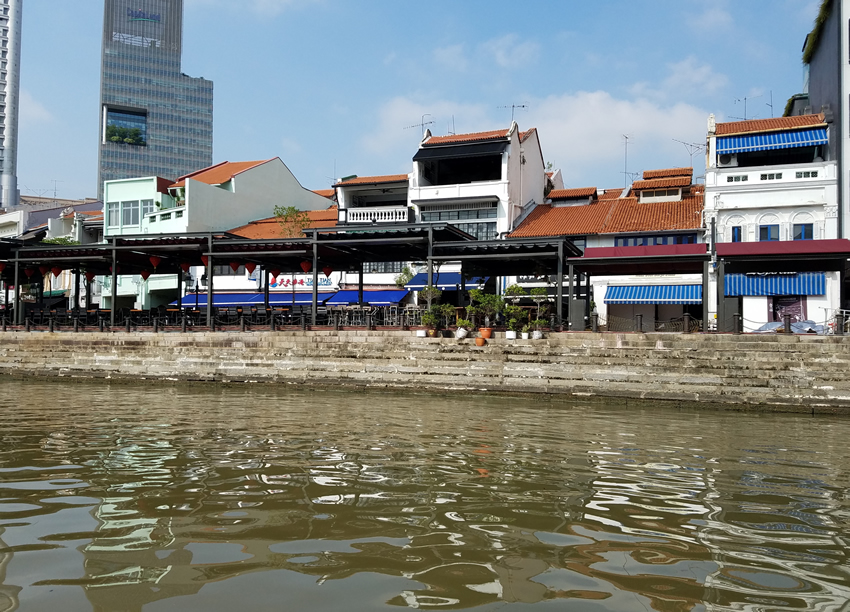
From the cruise, we went to the Marina Bay Sands Hotel ($318 a night). Walking through the expensive shops made re realize that there were so many things ($$$) that I could do without. Keeping with the expensive motive, the inside architecture was very distincitve and breath taking.
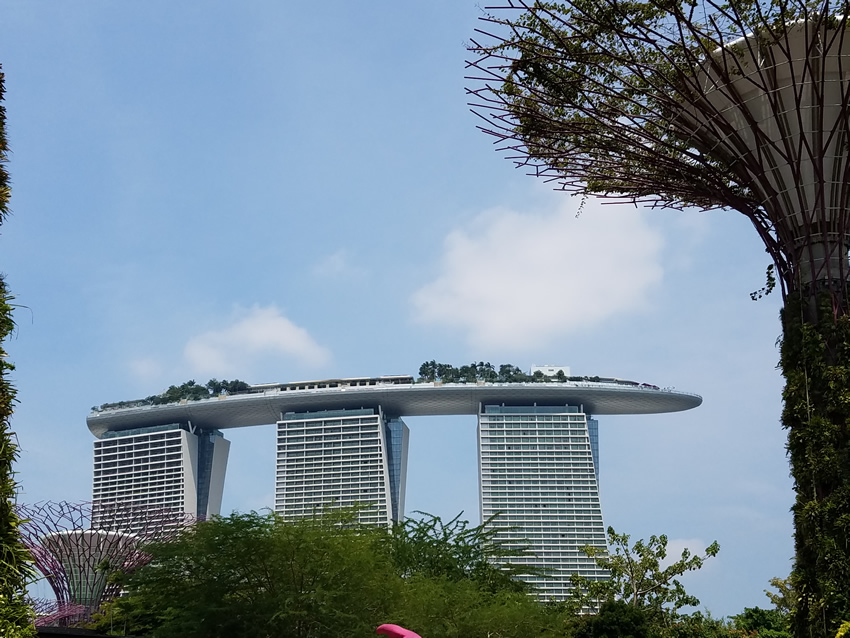
The goal for being in the hotel was the elevator to the observation deck on the 57th floor, seen here as the boat on top of the hotel. The structure to the right is one of the water reservoirs. We did not see the pool with the glass floor. Although at the top the temperature was 92 with 72 % humidity, there was a breeze up there making this a very pleasant experience.
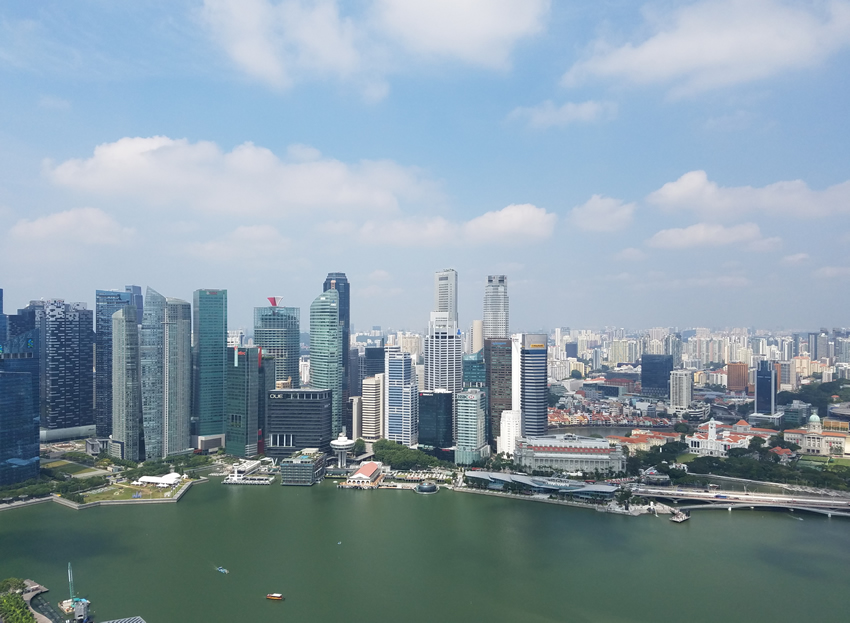
One of the many view from the top of the 3rd tower Marina Bay Sands Hotel, 2000 plus rooms hotel.
The Gardens by the Bay, which houses three different gardens, was our last stop. We had tickets for the Flower Garden and the Cloud Garden, two of the three different gardens. The flower garden has areas that are hot and dry to mimic a desert climate, areas that are temperate, as well as areas that are tropical, all with the appropriate plants. Acres of spectacular, and to me, strange, but beautiful flowers! When you enter the Cloud Forest, you immediately see a water falls (all indoors). After walking around the falls, a somewhat damp experience, you walk gently uphill admiring not only the plants and flowers, but also the views outside. On about the third level there is an elevator which takes you to the 7th floor where you can walk down viewing the plants on a circular trail that lines the outer wall seeing different plants all the time. As a cloud forest the climate is humid and cool, but comfortable. At one point, I saw the fly catcher and another insect eating plant. Another insect eating plant that emits an obnoxious odor of rotting meat to attracts insects was not there, but they do exist. These plants all, catch, eat, and digest insects.
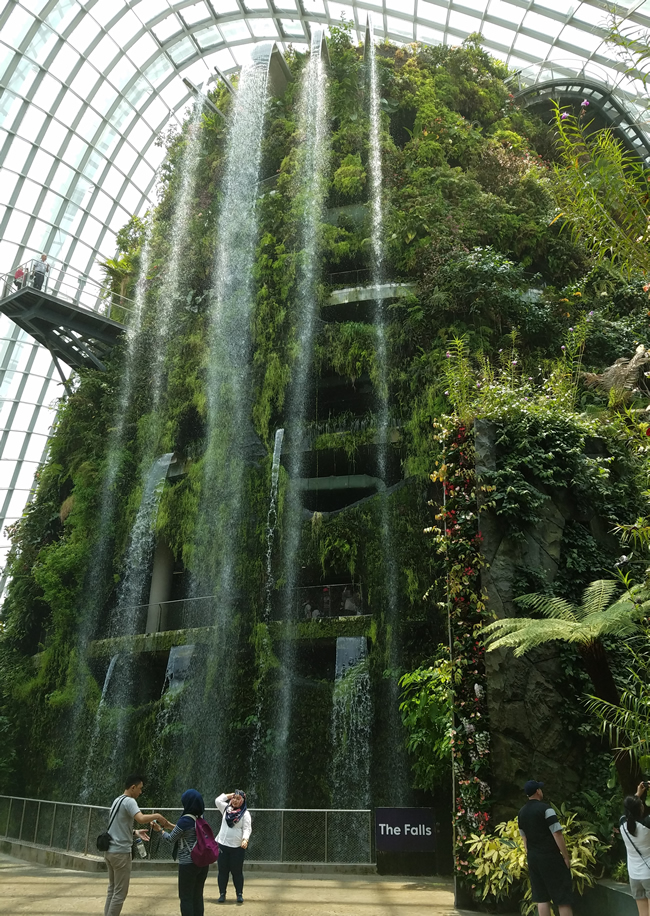
Singapore is at the mercy of Malaysia for its water supply. Relations, partly jealousy, are not always good which can present difficulties. The Singaporeans have built a desalinization plant, catch as much rainwater as they can, and have reservoirs. Some of these reservoirs are located near the Gardens. They are on a high pole, with a huge saucer shaped rain collector on top. To hide their somewhat unsightliness, plants that grow in air and do not require water have been introduced and are slowly growing around the spokes. Except for their height, the shape reminds me of the outdoor clothes hanging poles which open like an umbrella except they have lines for hanging clothes instead of a solid cover.
That night I joined another ship tour along with some friends and we took the Night Animal Safari. My daughter, Laura, had told me that this was a “don’t miss.” This park features animals that are night creatures and does not open until 7P. Our tour started with a tram ride through some of the park where we saw the mice deer – they are the smallest deer known, elephants, buffalo, tigers, and even a giraffe plus some others too numerous to remember! The tram passes close to the animals, but an invisible, not electric, fence separates us. Additionally, there is a moat which one has to look closely to see.
After the tram ride our guide lead a group of us on the Fishing Cats trail. Indeed, they are cats, and they do fish. We must have been there at the right time because they were fishing, but that did not last. More mice deer, and my favorite, the baby otters playing. I could have stood there all day! And many more animals. The end of the tour was an animal show. The trainers brought out animals, but from the top entrance to the amphitheater so they walked right by the audience. I cannot remember the name of the first animal, but it acted a bit like a possum and racoon, but was all black. An audience volunteer, a young boy, was asked to come to the stage. He was given a grape and asked to smell it – to demonstrate that to humans it had no odor. Then that aforementioned animal had to select in which hand the grape was hidden. Of course the animal was successful. Two different owls were also exhibited as was an 8 foot snake, for which they got two volunteers from the audience to help bring out.
The last Singapore tour was to acquaint us with the Peranakan Culture. Today it is a mixture of many cultures and nationalities, but still its own culture. Partly Chinese, but there is Malay, Indian, and even a little Arab thrown in. The story about their beginning dates back to the early 1400s. Zheng He, a famous Chinese admiral, sailed these waters all the way to Africa. (His ships were about 4 times the size of Columbus’s largest ship. One author, Menzies, argues that he reached the Americas, but has little agreement.) Back to the story, on one of his journeys he called at Malacca and met the Sultan who gave him many gifts. Feeling a need to reciprocate, he returned to China and obtained 200 Chinese virgins, carried them to Malacca and gave them to the Sultan. Many of them married the Malaysians creating mixed descendants who continue to mix! It is said that this was the beginning of the Peranakan culture.

The area features two story houses, each painted a different color, with decorations. It all makes an interesting scene. We visited what they call a delicatessen, but we would call a sweets shop and had a chance to sample some – delicious, but not sicky sweet. Other parts of this shop had embroidered goods for sale – not inexpensive! I need to explain that a woman is judged by the bride’s family as to whether she will be a good bride by her needlework. To the point where it was not unheard of for a family to hire someone else to produce the goods that must be examined by the women in the groom’s family to determine if she was an appropriate bride.
In another room in this shop there was a Chinese Wedding Bed. They are made in China, heavily decorated and shipped at great expense to Singapore. Weddings are a cause for a great show and celebration. The idea of importing this bed is to show that one has wealth – keeping face is still very important to all Asians. Interestingly the wedding customs in SE Asia seem to start with the bed. In Vietnam and China both, the groom comes to the bride’s house and presents gifts. The bride is in her bedroom lying on the bed. The family have hidden her shoes and the groom has to find them so they can proceed with the ceremony, no, the ceremony is not in the bedroom. He easily finds one shoe, but the family have hidden the other very well and require the groom to pay more money to produce it.
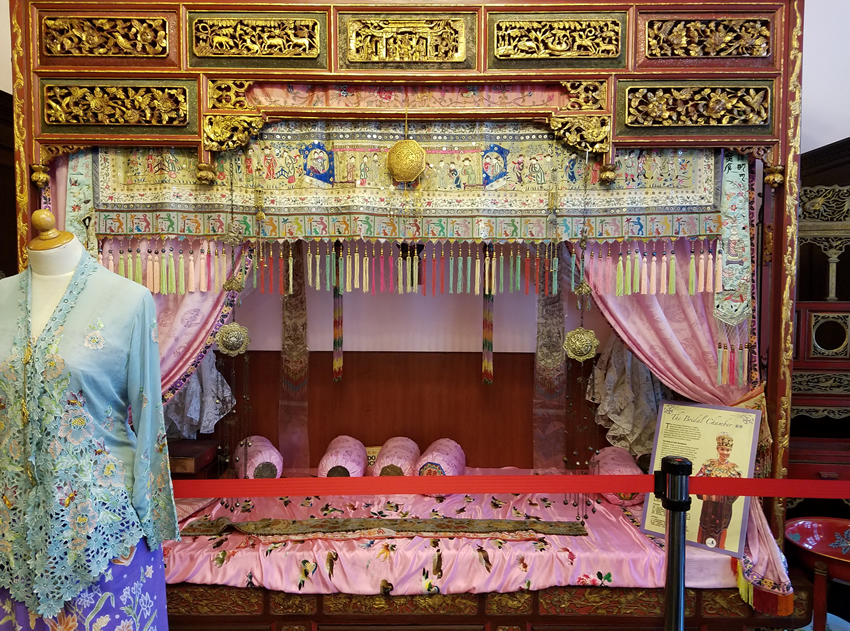
Note the embroidery on the top to the left of the Bed.
Singapore has a very strong, technologically advance, military, and have been guided by the Israelis in its development. They also have an air force, based in Colorado. No room for it on the island…
The Israelis also designed their security. Both disembarking and reboarding were tedious processes requiring 15 to 20 minutes. As usual, the Amsterdam crew scanned our key cards just before we left the ship so they knew that we were not aboard. This was not enough for Singapore. Before we could even enter the long, back and forth, passageways to the terminal we had to show our passport and landing card which the ship personnel had put into our passports. Once in the terminal, our passports were put through a machine to record our entry, then the next step was to have our day bags x-rayed and walk through a metal detector. Returning to the ship was a reversal of this process. In all ports, reboarding the ship requires the obligatory ship card scan, passing through a metal detector, and x-raying of our bags. The main thing the ship is checking for is to be sure that we have not brought alcohol aboard – to do so requires paying a corkage fee of $15. However, in Singapore the only step to stepping aboard the ship after Singapore security was to show our keycard to be scanned to record our reboard.
It is going to be interesting to see if India is as thorough. My reasoning is the micky mouse that we had to go through to obtain a visa. They had to see a photo copy of my driver’s license, my marriage certificate because 55 years ago I changed my name, and my birth certificate. But as Doug, one of my sons who has done business in India says, “The Indians love paperwork.” And my good neighbor, Susan, a Brit, adds, “We taught them well.”
We left Singapore at 7:PM. Out of curiosity I went to my stateroom and watched for over 30 minutes until we cleared all the anchored ships. There is a whole lot of shipping that has nothing to do with the U.S.
Singapore is all that it is cracked up to be. It surpasses Shanghai and Hong Kong as a place to visit. Although I liked both those cities, and loved Japan, this has to be my favorite port so far. I doubt if it will be surpassed.
